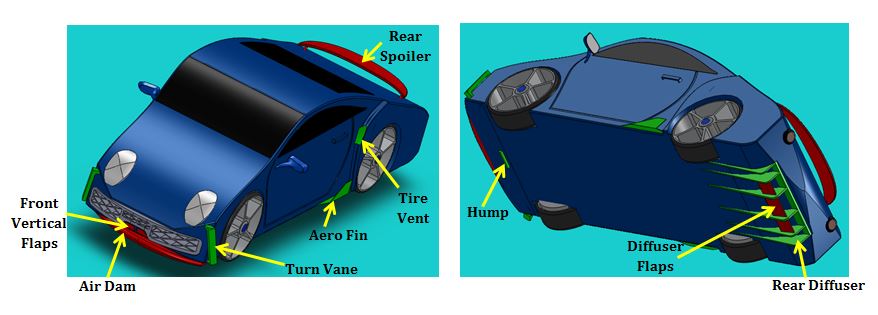Active Aerodynamics
by Deanna Mock, Clemson Mechanical Engineering Student
- Basic Description
-
Aerodynamics has been incorporated into automotive design for several decades, as it has been long known that the shape of a vehicle influences its performance. In designing aerodynamic features on cars, two main concepts are considered: downforce and drag. Downforce uses areas of low pressure to keep the vehicle on the ground and improve handling and brake response at high speeds, so it is especially useful for sports cars. However, certain aerodynamic features that increase downforce on a car also can increase drag, which forces the car to require more power to maintain a speed. Thus, automotive designers seek to find an optimal balance between the downforce and drag on a vehicle. The most common method of doing this has been to incorporate features into the frame of the car, such as spoilers, diffusers, and basic integration of lights and wheel arcs into the general shape of the car. However, in the past fifteen years, active aerodynamics has been introduced as an additional method to improve fuel efficiency while maintaining optimal performance at high speeds.
Active aerodynamic systems typically adjust certain aerodynamic features on a car based on the speed of a vehicle. However, other information such as acceleration, yaw rate, steering wheel angle, and brake input, is also used in determining the system level of response. The figure below displays several aerodynamic components that are incorporated in various vehicles today. Those highlighted in green are integrated into the frame and have not yet been used actively, while those highlighted in red are active systems in certain automobiles.
Aerodynamic Vehicle Features
-

-
The stationary aerodynamic features focus on directing the air rushing into the car to optimal locations. Tire vents, for example allow the air to cool the tires and brakes, thereby improving fuel efficiency and prolonging the life of those components. Turn vanes and aerofins direct some of the air around the car to the tire vents and increase the downforce on the car. The hump and diffuser channel the air under the car and enable greater extraction of the air flow. This creates an area of low pressure, increasing the downforce and stability of the vehicle.
The active aerodynamic features enhance the performance of the stationary components. In a Porsche 911 Turbo, for example, the rear spoiler and air dam synchronously expand and retract upon reaching certain speeds. In their original, low speed position, they provide adequate downforce and stability for the car. However, their expansion at higher speeds increases stability and minimizes the drag coefficient at that speed. Front vertical flaps and rear diffuser flaps are features on a Ferrari 458 Speciale. The flaps on the rear diffuser rise to increase air extraction capacity from under the car, while the front vertical flaps open to generate downforce, balancing that created by the rear flaps. The front flaps also open to direct the air flow to the turning vanes and allow more air inside the car for engine cooling. The video below demonstrates the motion of each of these active components.
Active Aerodynamics Demonstration
-
Although most active aerodynamic systems are used in race cars, other high end vehicles (like the previously mentioned Porsche 911 Turbo) have a few implementations. Certain BMW cars and the Ford Mustang have active grille systems that reposition at higher speeds to reduce drag, thereby decreasing fuel consumption, when no extra cooling capacity is required. Audi also has an active design using shutters between wheel spokes that open and close according to the same logic as the active grille shutters. The main difference is that this system would be specifically for brake cooling whereas the grille system would focus more on engine and radiator cooling.
- Sensors
- Acceleration Sensor, Brake Sensor, Engine Temperature Sensor, Steering Angle Sensor, Vehicle Speed Sensor, Yaw Rate Sensor
- Actuators
- Air dam, flaps in front splitter and/or rear diffuser, rear air-brakes, rear spoiler, wheel shutters
- Data Communications
- Typically Control Area Network (CAN)
- Manufacturers
- Audi, BMW, Ferrari, Ford, McLaren, Pagani, Porsche
- For More Information
- [1] Automotive Aerodynamics, Wikipedia, March 13, 2014.
- [2] Ferrari 458 Speciale - Aerodynamics, YouTube, October 8, 2013.
- [3] The McLaren P1: Making Hyper Advanced Aerodynamics Gorgeous, Jalopnik, September 27, 2012.
- [4] Pagani Huayra Aerodynamics [Video], Pagani Review, December 12, 2011
- [5] 2014 Audi 7 Retractable Spoiler, YouTube, November 30, 2013.
- [6] Diffusers - Engineering Basics - Aerodynamics, Racecar Engineering, April 15, 2009.
- [7] Auto Future: Active Aerodynamics, David Moreria, The Truth About Cars, January 8, 2009.
|

